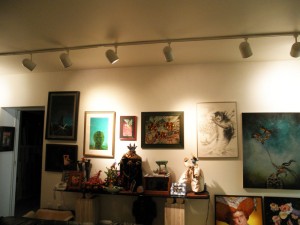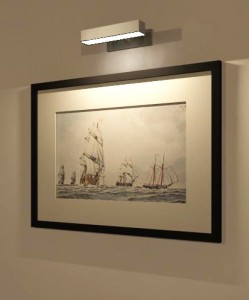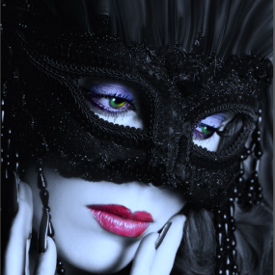
Clearly (no pun intended), art needs to be seen to be appreciated . . . and that means LIGHT. More importantly, however, you cannot properly experience art (spiritually, emotionally or intellectually) without the right lighting. More essential than any other decision, more important than the room you choose or where on that wall it hangs, and certainly more important than its frame, is: lighting. This is a decision that’s critical to the enhancement of your collection, or – quite literally – its destruction.
Lighting design is more than just screwing in an adequate number of light bulbs. Merely adequate is the way masterpieces are exhibited in museums around the world. Great artworks, viewed in dim light and from a distance. . . . that may be a requirement when we’re discussing a priceless Titian, El Greco or Rembrandt exhibited in cavernous spaces – where thousands of (potentially spitting and sneezing) visitors a year must be kept safely away from priceless objects . But this is not the case for the preponderance of private collections, where the conservation requirements are less stringent,

and the art is meant to be enjoyed “up close and personal”. We are stewards of the art, to be sure – but yet want visitors to appreciate the nuances of the works, and be able to discern the shadows and surface textures. and see all colors and lines clearly. For us, lighting can be brighter . . . but still it must be unobtrusive, flexible and safe.
LIGHTING
The choice we made as collectors helps to bring the art we own, to life. And lighting is an integral part of that process, because light reveals the artist’s message. Lighting creates a mood, an ambiance, a psychological state of mind. Think: brightly lit shopping malls vs. dimly-lit bars. That is why you must carefully consider the purpose of the space. A space is not just a group of wall measurements, it’s defined by the needs of the art owner in combination with the expectations of the viewer. Whether you are dealing with a specific, stand-alone piece or a grouping of artworks, lighting is the key to making the concepts and ideas conveyed by the art meaningful and even significant, to the viewer. An entrance hall, regardless of the wall space (for example) carries different expectations from viewers than walls viewed when climbing up and down stairs; than walls viewed in bathrooms; than walls viewed above mantels in living rooms, or from chairs at dining room tables. Right? Think: in what situations do you expect lighting to be bright vs. creating a mood, or expect it to emanate from the ceiling or wall fixtures or table-top?

At the same time, the purposes of the spaces we occupy often must serve more than one function. What might be “good” lighting for watching “Dancing with the Stars” is not so good for sewing, and a romantic candle-lit dinner will make it difficult to appreciate the art on the wall. How to deal with multi-functional spaces? Easy. Create multi-functional lighting options. You know, give yourself CHOICES: lights that can be raised or lowered in intensity (see dimmer switches), lights that can be directed/changed in position (track lights), lights with tight vs. broad focal points (spotlights). Why do we even need to make those decisions?
Safety First
This is one time when “let the sun shine in . . . ” is NOT a good idea. When it comes to artwork, natural light is not only “not enough” to see art well, or even make it look good, but it can be dangerous to the health of the art, itself. Quite apart from only making some art on some walls look nice for part of the day….it’s obviously useless when the sun goes down. More importantly, in the HIERARCHY OF LIGHTING CONCERNS (and see below) “first do no physical harm” has got to come at the top of the list for lighting choices . . . and the sun (or any heat source) can be lethal to artwork.
There’s a reason why even art galleries with HUGE windows and tons of light pouring in, have all the artwork lit with high intensity, “cold” bright white clean artificial spotlights. It makes the art look good, and expensive, and like it’s hanging in a gallery. Can you emulate that look at home? Sure. Yet, once people get the art home they turn on the table lamps and then wonder why the art doesn’t look as good as it did when they bought it. If you are investing in art for your pleasure, and spending money on fancy frames to make it look “just right” – then why, oh why, aren’t you investing in the kind of lighting that will allow you to enjoy it? And keep it safe?

In the Hierarchy of Lighting Concerns, your chief worry should be how lighting will physically affect the artwork. Too much light, the wrong kind of light, and/or a light source that is close enough to the art to heat the surface can actually destroy works of art. Sunlight in general is the worst kind of light for any kind of artwork, but any situation which causes artwork to experience rapid or extreme changes in temperature are bad. Longevity is greatly affected by light. So-called “picture lights” that are attached to frames of paintings at top or bottom and throw light directly at one spot continuously from a distance of mere inches, are the worst possible choice for lighting art. The paint heats up, the glazes can melt, the paint can dry out and crack, and certainly: colors will be permanently altered wherever that light is shining.

Works on paper, and most especially those created with non-lightfast media such as watercolors, gouache and so on are highly susceptible to fading, drying out, and going brittle. Glazing which blocks out ultraviolet light is a must. For these works, low natural light is ok, as are brief period of artificial light, so long as they are properly glazed. But if you truly care about preserving original watercolors you might consider doing as connoisseur collectors do, and keep them in flat files between layers of tissue paper, perpetually “in the dark”.
Flexibility
What works for one piece of art may not not work for another; this is why ghu invented narrow and broad beam light bulbs 

Oil paintings can be difficult to light because of the surface texture and the way the paint interacts with light. Artists are keenly aware of this, and even minor changes in the lighting in their studios (i.e., painting in the morning vs. afternoon, using natural light) can greatly alter the way they mix their colors. Full spectrum lights, not too “cold” and a broad-based light source would probably be best. Acrylic paintings are not glossy (most of the time) and so don’t have the glare problems associated with oils or artwork framed under glass. But for any works under glass, reflection and glare will be problematic unless non-reflective glass is used and there is proper placement of lighting. For artwork in 3D, the goal would be to see it from all dimensions – entailing lighting from three different angles. But usually we settle for a single light placed directly above the work, angled downward – and a turntable pedestal (manual or motorized) for any works that are small enough for that kind of treatment.
I mention “full spectrum” lights above: this is a lighting industry term for lights that mimic the properties of sunlight and associated color “temperature”: not too cold a light or the artwork will look “blue”, and not too warm a bulb or the paintings will look too reddish-yellow. There are some good articles online that explain the complexity of these decisions from an artist’s point of view, which are helpful for collectors, as well.
The reason we invest in things such as track lighting or replacing recessed lights with directional lights is because it gives us flexibility – obviously. By simply changing a bulb and the angle of the beam, we are free to change the artwork on our walls. For artwork on stairwells, there are pendant lights; track lights on stems of various lengths. Yes, it is an added expense. But once done, you never need do it again.
Seen but not . . .
The beauty of proper lighting is that it doesn’t detract from the art; it doesn’t call attention to itself at all. It should not be obtrusive, it should not be “in the way” – the right lighting, in fact, is the kind that you aren’t even aware of. That element, unobtrusiveness, is the main reason why galleries make lighting art their highest priority. It is an essential sales tool. . . but one that we are hardly aware of when we’re “browsing” in a gallery. It’s why the art doesn’t look the same when you get it home. But it could!!!










